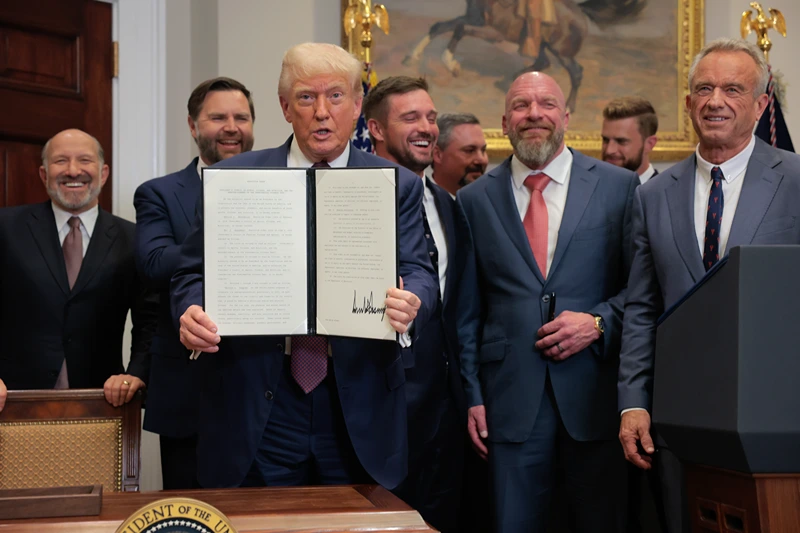


OAN Staff Blake Wolf and Brooke Mallory
5:04 PM – Thursday, July 31, 2025
President Donald Trump signed an executive order (EO) on Thursday reestablishing the Presidential Fitness Test, which former Democrat President Barack Obama phased out in 2012.
The program was created to promote an active, healthy lifestyle among children in the U.S., which is in line with Health and Human Services (HHS) Secretary Robert Kennedy Jr.’s “Make America Healthy Again” (MAHA) initiative.
“This is an important step in our mission to make America healthy again,” Trump stated during a press conference. “It’s something that’s very important, what we’re doing, very important. Dating back to the administration of President Dwight D Eisenhower, this council has championed the vigor and strength and vitality of the American people today. We continue that very proud tradition.”
Trump was joined by Kansas City Chiefs kicker Harrison Butker, as well as golfer Bryson DeChambeau, football player Lawrence Taylor, and wrestler “Triple H” at the signing ceremony of the executive order reviving the Presidential Fitness Test.
“I was always a person that loved playing sports. I was good at sports,” Trump added. “When you are really focused on sports, you’ve thought about nothing else. To an extent, this is one of the reasons I like gold. You get away for a couple of hours.”
The Presidential Fitness Test mandated that public schools assess students’ physical fitness through activities such as a one-mile run, sit-ups, push-ups, pull-ups, and the sit-and-reach flexibility test.
The President’s Council on Youth Fitness was established in 1956 by President Dwight D. Eisenhower. The creation of this program was motivated by concerns over the declining physical fitness of American youth, especially when compared to children in European countries. Eisenhower’s concern was sparked by a 1953 study conducted by Dr. Hans Kraus and Dr. Sonja Weber, which found that nearly 58% of American children failed a basic fitness test, compared to only 9% of European children. This study received widespread attention and alarmed U.S. leaders, who saw physical fitness as a matter of national strength and security during the Cold War.
The Council’s role was to raise awareness and promote youth fitness, but there was no formal awards program yet.
Additionally, President John F. Kennedy expanded the program significantly. He renamed it the President’s Council on Physical Fitness and strongly promoted physical education for America’s youth. However, still no formal award system was in place.
Then, in 1966, the Presidential Physical Fitness Award Program, which honored top-performing students, was established during President Lyndon B. Johnson’s administration.
| Year | What Transpired |
| 1956 | President Dwight D. Eisenhower creates the President’s Council on Youth Fitness after concerns about declining physical fitness in American children. |
| 1963 | President John F. Kennedy renames it the President’s Council on Physical Fitness and promotes youth fitness nationally. |
| 1966 | Under President Lyndon B. Johnson, the Presidential Physical Fitness Award Program is formally established to honor students who scored in the top 15% on a series of fitness tests. This marks the official launch of the award-based Presidential Physical Fitness Program. |
“In December of 1960, a month after he won the election, my uncle [John F. Kennedy], who was able to be president and wrote an article for Sports Illustrated called ‘The Soft American.’ And he was lamenting the fact that America had prided itself on its beef jerky toughness and that we were losing — that we were falling behind Europeans, we were falling behind other nations. And he was signaling with that article that he was going to make physical fitness of our kids the centerpiece of his administration,” Kennedy Jr. stated.
“And I’m so grateful to President Trump for bringing back this tradition,” Kennedy Jr. added. “We need to re-instill that spirit of competition and that spirit and that commitment to nutrition and physical fitness.”
Obama previously replaced the test with the Presidential Youth Fitness Program, which intended to “move away from recognizing athletic performance to providing a barometer on students’ health,” in addition to “minimiz[ing] comparisons between children and instead support students as they pursue personal fitness goals for lifelong health.”
The test was previously administered to high school and middle school students, although certain elementary and private schools included the test in their program as well, despite the presidential award only being eligible for 10 to 17-year-old students.
Stay informed! Receive breaking news alerts directly to your inbox for free. Subscribe here. https://www.oann.com/alerts
What do YOU think? Click here to jump to the comments!